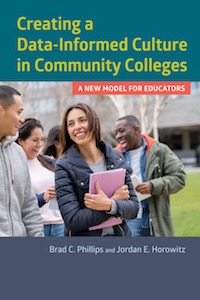case studies
Select an item by clicking its checkbox
The seminary professor, a man of color, just walked out of the academic dean’s office. He had been teaching at the mainline Protestant theological institution for eleven years. The academic dean, a white woman, called him into her office to talk about a recent article he published in a ...
Date Reviewed: December 10, 2019
Armed with strong backgrounds in institutional research and effective educational leadership, Phillips and Horowitz provide educators with an excellent resource for improving academic success with proven data use strategies and practices for community colleges. A central, uniting focus of the book is the need for information to be contextual, “useful, useable, and actionable” (9), and the need to enlist the widest number of stakeholders within its ecosystem. Administrators, researchers, faculty, and staff are encouraged to be co-partners in cultivating academic excellence.
Rather than placing data at the center, the authors advocate for a model that places “the use of data” at the center. The book is divided into three sections: (1) “A New Model for Data Use,” (2) “Putting the Model to Work,” and (3) “Case Studies of Data Driven Reform.”
The first part outlines a new model for data use that is user-friendly, improves educational instruction, and maximizes student success, combined with intentional adaptation to those it serves. For example, “few educators want to [be] analysts; they want to be provided with useful information and assisted in applying it toward student success” (56). Attention is also given to analytics, behavioral economics, organizational theory and habits, and the role of emotion in decision making.
In the second section, Phillips and Horowitz reveal a data use model that is put to work removing obstacles to student success. Specific consideration is given to leading and lagging indicators and the employment of backward mapping that begins with the identification of lagging indicators or goals. Attention is then refocused on the leading indicators that influence them, and which a college has the ability to control and reshape in proactive ways. Lagging and leading indicators have the ability to switch places from time to time. Scrutiny is also given to disaggregation and how different demographic subpopulations can impact the design of programs, services, and policies. The authors make use of a four stage, continuous improvement approach for use of educational strategies that moves from assessment, to planning, to implementation, to monitoring, and back again to assessment (110). They believe that data should be processed in manageable bites and reflect an institution’s unique cultural context and problem areas (176).
When evaluating outcomes of particular programs or services, Phillips and Horowitz call for academic institutions to review all other policies and programs that may or may not have an impact, positively or negatively. When introducing data and discussing it educators need to make sure that the content is real, that they include moments of humor, that they engage with the data, and that it works towards a consensus in decision-making. Resistance is another key factor for community colleges to scrutinize. College staff often bring their “own history of belief and experiences to the process and accept only information that confirms those beliefs” (104). Helping people to move outside their comfort zones and embrace change can assist in creating a positive, data-informed culture.
The last section provides actionable approaches and case studies drawn from community colleges from differing socio-economic and ethnic settings that intentionally choose to embrace a data-informed culture and foster proactive uses of information for student success. A failing institution was among the colleges examined – it had been on the verge of being shut down by state authorities because of dissatisfaction with its academic quality and student success.
This book is more than a guide for interpreting data by academic researchers. It also provides a research-based, comprehensive, and practical approach for improving academic excellence in all areas, and amongst all segments of the college community. This book will help teachers of religion and theology to increase their classroom effectiveness – in lecturing and interacting with students.
 NOTE: Use the playlist button located in the top left of the video window above to switch between episodes.
NOTE: Use the playlist button located in the top left of the video window above to switch between episodes.
Problem-Based learning at Maastricht University (4:38)
Although a promotional spot for prospective students, this video nicely details goals, roles, stages, and terms common in “problem-based learning.”
Project Based Learning: Explained (3:49)
Through examples, the video promotes this method’s educational value and capacity to develop critical thinking, cooperation, and communication.
Problem-Based Learning at SIU PA Program (11:25)
Goals, roles, and stages (including self-assessment) of problem-based learning demonstrated through a case study approach to physician assistant training. Video emphasizes the active learning dimension of problem-based learning.

Leadership Case Studies in Education
Date Reviewed: May 13, 2016
Northouse and Lee adopt the definition of leadership put forth by Northouse in his influential textbook Leadership Theory and Practice: “Leadership is a process whereby an individual influences a group of individuals to achieve a common goal” (2). The co-authors state that the common goal of educators is “to create a safe place where students can effectively learn and grow” and so it follows that leadership – the process of influence – is central to the educators’ vocation (2). During the past one hundred and fifty years, researchers have offered multiple approaches to understand precisely how leadership works, and Lee and Northouse succinctly summarize various approaches and provide case studies based on actual situations in education to help readers to apply the theoretical concepts. Following their introduction, each of the remaining fifteen chapters in Leadership Case Studies in Education presents one theory for understanding leadership along with two case studies, one focused on K-12 and one in higher education.
The first half of the book generally parallels developments in leadership research in the twentieth and twenty-first centuries, beginning with theories that hone in on the leader’s characteristics or actions (trait, skills, and behavior) and moving to theories that explain group processes (situational, path-goal, and leader-member exchange). Chapters eight through ten examine more recent descriptions of th e qualities of a leader presenting transformational, authentic, and service leadership theories. These are followed by chapters on adaptive leadership, psychodynamic approach to understanding leadership, ethics, and team leadership. The book concludes with case studies that highlight the significance of gender and culture.
The sixteen higher education case studies cover a range of leadership positions. Three of the case studies feature a university president; six present situations faced by administrators or staff working outside of academic affairs; one is about a student leader; and six focus on faculty. A set of six questions concludes each case study. The first three directly address the case study, while the second set connects the case study to Northouse’s text.
Northouse and Lee wrote Leadership Case Studies in Education as a companion text to Northouse’s Leadership Theory and Practice. The case study text offers compact summaries of each leadership theory, which are intended to serve primarily as review of the more thorough presentation and assessment in the main text. For example, in Theory and Practice, Northouse devotes thirteen pages to leader-member exchange theory, describing early and later studies, explaining how the theory works, presenting its strengths and limitations, and suggesting possible application. Case Studies condenses this to less than three pages.
Northouse and Lee write that their intended audience is “undergraduate and graduate classes in education and educational leadership,” (ix) so it is not surprising that its usefulness to this audience may be limited. The case studies draw on real-life situations but are missing discussion and analysis. This may be a useful companion textbook for classes in educational leadership, but without the corresponding textbook Leadership Case Studies in Education misses an opportunity to influence readers outside the classroom in the common goal of improving education.

Teaching with Cases: A Practical Guide
Date Reviewed: March 14, 2016
Some academic disciplines such as law and medicine have a long history of using case teaching as a pedagogical approach while other disciplines seldom employ case teaching. Espen Andersen, associate professor in the department of strategy and logistics at the Norwegian Business School, and Bill Schiano, professor of computer information systems at Bentley University, drawing from their experience of using case teaching in business schools, demonstrate the positive impacts case teaching can bring and provide a practical guide for instructors who would like to adopt this pedagogical approach. As readers move through the content, they will discover that the book covers topics broader than case teaching and offers rich insight into how classroom discussions can be effective toward student participatory learning development.
As indicated in the title, Teaching with Cases is a practical guide. It is not only a practical guide for teaching with cases, but also covers basic teaching skills and techniques. These include: how to develop content; writing a syllabus; planning a class session; using guest speakers; employing role play; designing group discussions, assignments, and grading rubrics; debriefing a course and using feedback; handling small details such as seating arrangement; using technology; managing breaks and classroom behaviours; and using the white/blackboard effectively. The book is a comprehensive manual for teachers, new or experienced.
While the comprehensiveness of the book is to be commended, more in-depth insights about case teaching are lacking as the book wanders around discussion-based teaching techniques rather than focusing on how to use cases effectively. The most helpful piece on actual case teaching is chapter 6, “Quantitative and Technical Material,” where the important value of case teaching is spelled out: “to foster an intuitive understanding of a situation and to learn to think and make decisions like a manager” (174).The best illustration on a teaching case (Dell computer’s build-to-order) is also found in this chapter. More guidance on how to craft out an effective teaching case to be used in both classroom and online discussions would be helpful.
While I appreciate the authors’ sensitivity to language and culture as an issue in case teaching and an entire chapter devoted to addressing content and classroom dynamics such as gesture, custom, vocabularies, and so forth, the authors seem to generalize language and culture by national identities or geographical boundaries and fail to recognize the particularities and diversity with a culture. For example, Chinese students from Taiwan, Hong Kong, and mainland China have different cultural values and educational systems. Hence, their understanding of what connotes sound educational practices will vary as well. Even within those three localities, diverse expressions of customs and norms can be observed. To assume all Asian students think and behave the same way is problematic.
The lack of a strong conclusion that ties it all together is a disappointment, especially since the book covers such a broad range of teaching skills and techniques. Overall, Teaching with Cases is a helpful guide for instructors, particularly those who are interested in engaging students in participatory learning. Readers may also find additional supplementary materials for this book online at http://academic.hbsp.harvard.edu/teachingwithcases.

